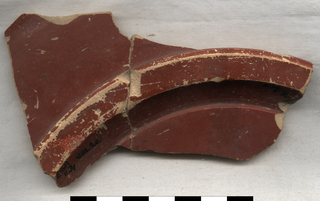
2,000 years later.. still here...
In 1977, I was one of thousands of young backpackers in Jerusalem.
One day, while wandering around East Jerusalem, I walked into The Albright Institute for Archaeology at 26 Saladin Street.
I had no business going in there. I was not an archaeologist. I was just hot and bored and curious.
As I wandered in the nearly empty building, I was approached by a woman.
"Are you an archaeologist?" she asked. I think she was just saying, in the nicest way possible, 'what the hell do you think you are doing trespassing here on private property?'
I paused, caught. "No," I responded. "I am a photographer."
I felt I needed some kind of identity, and I did have a camera.
Her name was Dr. Sharon Herbert, and she was indeed an archaeologist. She was, in fact, the head of the Kelsey Museum at the University of Michigan, and she was heading up a dig in Israel.
She paused and took a beat. This was not the answer she had been expecting.
"My photographer has just quit," she said. "Would you be interested in becoming the photographer for my excavation?"
And so I became the official dig photographer for the dig at Tel Anafa, in northern Israel,
I had never been on a dig before and knew nothing about archaeology.
On one of the first days on the site, Dr. Herbert handed me a broken piece of pottery, a pot sherd that the team had lifted from the ground. Ancient Greek, she said.
As I turned it over in my hands, I noticed some letters scratched onto it. These are called ostricon - writing on pottery. This was, in effect, a message from someone that was more than 2,000 years old. Still here. Still readable.
In 1986, The BBC set out on an interesting project. To demonstrate the cutting edge of technology, they created a copy of the Domesday Book on an optical disc. The Domesday Book was and is the register of all the lands and properties in England, commissioned in 1086 by the new conquerors, the Normans, to get a grasp of what they owned. It was written by hand in ink on parchment. 1986 was the 900th anniversary of The Domesday Book, and The BBC project was supposed to preserve The Domesday Book for 1,000 years for future generations - at a cost of £2.5 million.
Today, the optical discs that hold The Domesday Book still exist. Except no one can read them. There are no longer any Optical Disc readers.
You can still read The Domesday book in the original parchment, of course. And you can still read the ostracon on the Greek pottery at the Kelsey Museum in Michigan.
I am writing this not on a piece of pottery, nor on a piece of parchment. Nor am I engraving this in stone. Instead, I am writing it on a piece of software that will probably not exist in another 20 years, on an operating system that will probably be dysfunctional in 5 years, and I am not really even writing it. I am just creating strings of code that will vanish with ease.
In the past few years, our entire world of collective creativity has moved from the physical world - paper, photographs, celluloid - to the digital world - long strings of zeroes and ones. And as the technology changes, and it does faster and faster, that world becomes increasingly irretrievable only a decade hence, let alone 2,000 years later.
All the wedding videos of my past marriage were shot on Hi8 video. (As I divorced - and later remarried - I don't much care that all of that is now irretrievable, but it's a sign of a problem).
The problem is that despite our prodigious output of content - more photographs are taken every 2 minutes than were taken in the entire 19th Century - almost all of it, if not all of it, is likely to simply vanish. Ironically, the few printed photographs from the 19th Century are far more likely to survive into the 22nd Century than all the billions of images we upload to Instagram.
Digging up the past was and remains fascinating. But that is because our ancestors left a physical record behind. My fear is that 2,000 years from now, future archaeologists will wonder why civilization ceased to exist, apparently, early in the 21st Century.
"What happened to them?" they will ask.
Our 2024 Coverage Needs You
It's Another Trump-Biden Showdown — And We Need Your Help
The Future Of Democracy Is At Stake
Our 2024 Coverage Needs You
Your Loyalty Means The World To Us
As Americans head to the polls in 2024, the very future of our country is at stake. At HuffPost, we believe that a free press is critical to creating well-informed voters. That's why our journalism is free for everyone, even though other newsrooms retreat behind expensive paywalls.
Our journalists will continue to cover the twists and turns during this historic presidential election. With your help, we'll bring you hard-hitting investigations, well-researched analysis and timely takes you can't find elsewhere. Reporting in this current political climate is a responsibility we do not take lightly, and we thank you for your support.
Contribute as little as $2 to keep our news free for all.
Can't afford to donate? Support HuffPost by creating a free account and log in while you read.
The 2024 election is heating up, and women's rights, health care, voting rights, and the very future of democracy are all at stake. Donald Trump will face Joe Biden in the most consequential vote of our time. And HuffPost will be there, covering every twist and turn. America's future hangs in the balance. Would you consider contributing to support our journalism and keep it free for all during this critical season?
HuffPost believes news should be accessible to everyone, regardless of their ability to pay for it. We rely on readers like you to help fund our work. Any contribution you can make — even as little as $2 — goes directly toward supporting the impactful journalism that we will continue to produce this year. Thank you for being part of our story.
Can't afford to donate? Support HuffPost by creating a free account and log in while you read.
It's official: Donald Trump will face Joe Biden this fall in the presidential election. As we face the most consequential presidential election of our time, HuffPost is committed to bringing you up-to-date, accurate news about the 2024 race. While other outlets have retreated behind paywalls, you can trust our news will stay free.
But we can't do it without your help. Reader funding is one of the key ways we support our newsroom. Would you consider making a donation to help fund our news during this critical time? Your contributions are vital to supporting a free press.
Contribute as little as $2 to keep our journalism free and accessible to all.
Can't afford to donate? Support HuffPost by creating a free account and log in while you read.
As Americans head to the polls in 2024, the very future of our country is at stake. At HuffPost, we believe that a free press is critical to creating well-informed voters. That's why our journalism is free for everyone, even though other newsrooms retreat behind expensive paywalls.
Our journalists will continue to cover the twists and turns during this historic presidential election. With your help, we'll bring you hard-hitting investigations, well-researched analysis and timely takes you can't find elsewhere. Reporting in this current political climate is a responsibility we do not take lightly, and we thank you for your support.
Contribute as little as $2 to keep our news free for all.
Can't afford to donate? Support HuffPost by creating a free account and log in while you read.
Dear HuffPost Reader
Thank you for your past contribution to HuffPost. We are sincerely grateful for readers like you who help us ensure that we can keep our journalism free for everyone.
The stakes are high this year, and our 2024 coverage could use continued support. Would you consider becoming a regular HuffPost contributor?
Dear HuffPost Reader
Thank you for your past contribution to HuffPost. We are sincerely grateful for readers like you who help us ensure that we can keep our journalism free for everyone.
The stakes are high this year, and our 2024 coverage could use continued support. If circumstances have changed since you last contributed, we hope you'll consider contributing to HuffPost once more.
Already contributed? Log in to hide these messages.

